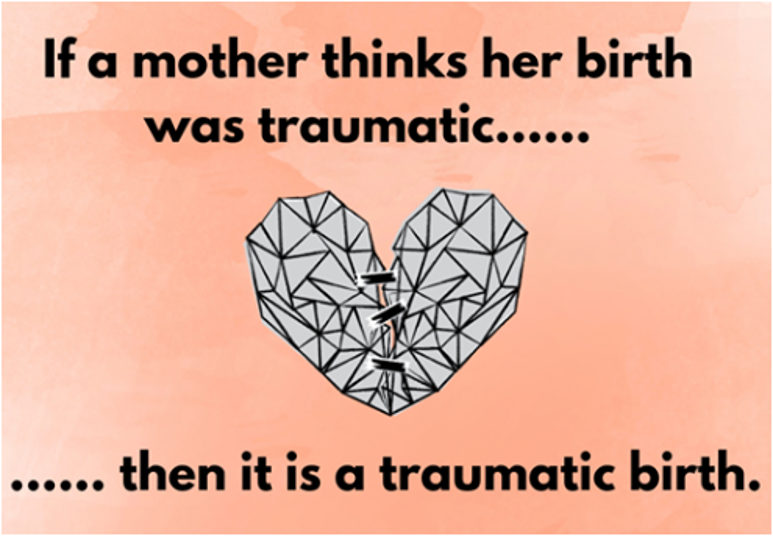by Tanya Thomas, APC
Recently, I saw this posted on Facebook.
A conference not too long ago stated that 34% of moms report that their childbirth experience was traumatic – and the OB next to me got really upset. She thought that was a ridiculously high percentage. The exchange set me thinking – what defines trauma? From a medical perspective trauma is an injury, a wound.
For many new moms the birth goes amazingly well – thanks to the medical care we have in this country. Some are injured – some have c-sections – some tear beyond the norm – some need help getting the baby to come out – all of these are physical injury or trauma. Trauma does physical damage that requires time to heal. That is what the OB understood.
But that is not what these moms are talking about with their traumatic births.
Themes around birth trauma center on four primary topics: the mother did not feel taken care of; the mother felt she was not communicated with; the mother did not feel safe; and the mother felt neglected in favor of the baby (Beck, p. 28). Birthing mothers often find themselves going from everyone encouraging them to take care of themselves (and remember the list of do and don’t eat foods from the OB?) to a live birth is the only goal.
The question arises – is the mom being taken care of too?
Being in such a vulnerable position – wearing nothing but a hospital gown – that does not stay closed, wires, monitors, I.V.s attached all over, feeling like a beached whale in pregnancy – leaves the mom feeling she cannot defend or take care of herself. From her perspective the experience of trauma becomes relevant.
Trauma, from a mental health perspective, while including physical or emotional injury can also include the perceived threat of injury. At a moment when a woman is most vulnerable – feeling out of control – of herself, of her body, and of the baby soon to be born – she is most susceptible to feeling threatened by the environment she is in, the people around her, the experience. While when she is dressed, not in labor, not attached to multiple machines she may find the situation suitable and non-traumatic.
Personal strengths and resilience in the moment are the defining force of whether an event feels traumatic.
Nine percent of women develop PTSD after their birth experience (Postpartum Post-Traumatic Stress Disorder). Please know that your experience was real – no matter what others perceived the birth to be – they were dressed; they made the plan of action when yours was off course; they did not feel restrained by wires or a large belly. You are not alone in your feelings. There is help and hope to recover from this trauma.
The first step is calling trauma trauma.
Beck, C. T. (2004). Birth trauma: In the eye of the beholder. [Abstract]. Nursing Research,53(1), 28-35. doi:10.1097/00006199-200401000-00005
Postpartum Post-Traumatic Stress Disorder. (n.d.). Retrieved from https://www.postpartum.net/learn-more/postpartum-post-traumatic-stress-disorder/
Learn more about Tanya and how she can help you, Here!
Follow us on Facebook, Instagram and Pinterest to see more advice from our therapists!
Une diminution des concentrations plasmatiques du tadalafil ne peut être écartée lors de l’association à d’autres inducteurs du CYP3A4, tels que le phénobarbital, la phénytoïne et la carbamazépine. Les études cliniques ont montré que le tadalafil 5, 10 et 20 mg majorait les effets hypotenseurs des dérivés nitrés. L’administration de Tadalafil Lilly à des patients qui reçoivent des dérivés nitrés sous n’importe quelle forme est donc contre-indiquée voir rubrique Contre-indications. https://www.cialispascherfr24.com/ Les résultats d’une étude clinique réalisée chez patients ayant reçu des doses quotidiennes de 20 mg de tadalafil pendant 7 jours, et 0,4 mg de trinitrine sublinguale à des moments variés ont montré que cette interaction a duré plus de 24 heures et n’était plus détectable 48 heures après la dernière prise de tadalafil.


Recent Comments